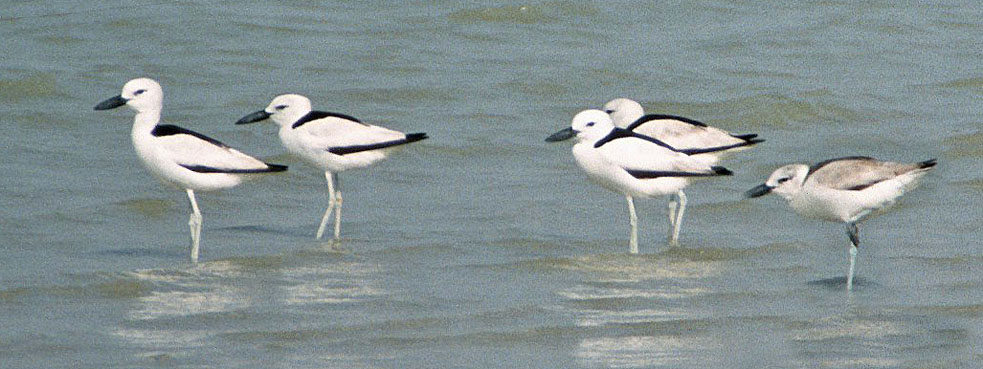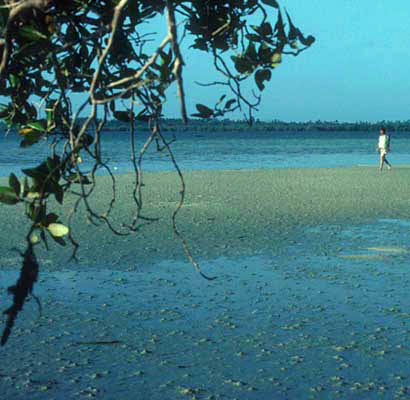
a web page by Don Roberson |
 |
CRAB-PLOVER Dromadidae |
|
It is an odd bird in many ways. Its pied plumage recalls avocets but it nests in burrows and its heavy bill is like those on Great Thick-knee Esacus recurvirostris or Beach Thick-knee E. magnirostris. Crab-Plovers feed almost exclusively on crabs — about 95% of prey during the breeding season —greedily dismembering the unlucky prey. At low tide they forage on exposed mudflats, but at high tide they use roosts with other shorebirds (above) or wade out among the flamingos (left, at Khor al Beidah, United Arab Emirates). The Crab Plover is also unique among waders by nesting in burrows that it digs itself, and each burrow has one egg. Daytime temperatures are so high that incubation is not alway necessary; sometimes an egg is left un-incubated for over two days without a problem. Crab-Plover chicks cannot walk at first and typically remain in the burrow for weeks before emerging, after which they continue to be fed by their parents for several more weeks.
|
 |
Small flocks of Crab-Plovers scatter more widely away from the breeding colonies during the non-breeding season, particularly along the coasts of east Africa, but also south to Madagascar and out to Indian Ocean islands, like the Seychelles. My first encounters were at Mida Creek mouth in Kenya (shown at right). In the non-breeding season they frequent mangroves as well as sandy beaches, coral outcrops, and even rocky coasts. Most taxonomists elevated Crab-Plover to its own monotypic family for for decades. Some ornithologists noted that burrow-digging behavior was like some auks, yet the tarsal scutellation and the counter-shaded unpatterned gray down of its chicks was unlike other shorebirds — in these features it more closely resembles gulls (Rands 1996). In fact Jehl (1968) divided all the waders into three groups on the basis of his study of downy chicks: the jaçanas & painted-snipes, the Crab-Plover, and then all the remaining families. This division — which elevated the Crab-Plover to its own superfamily — highlighted its uniqueness. Sibley & Ahlquist (1990), relying on DNA-DNA hybridization evidence, considered it a very odd courser (family Glareolidae). That analysis prove to be the most accurate. Molecular studies this century now place Crab-Plover as a monotypic family that is sister to the coursers and pratincoles in the Glareolidae (Hackett et al. 2008, Pereira & Baker 2010). |
Photos: The photos of Crab-Plover Dromas ardeola were taken at Khor al Beidah, United Arab Emirates, on 10 March 2001. The habitat shot at the Mida Creek mouth was taken near Malindi, Kenya, in Nov 1981. All photos © Don Roberson; all rights reserved. Bibliographic note: There is no "family book" per se, but Crab-Plover is often including in books on shorebirds or waders in the Old World, such as Hayman et al. (1986) and similar, newer works. A good introduction to this family, with some fine photos, is in Rands (1996). Literature cited:
|
 The Crab-Plover (above, left & below) is a dramatic wader of tidal mudflats around the Indian Ocean. Its distribution is very localized. Indeed, only nine nesting colonies were known in the entire world when a survey was take in 1990s. Over 1500 pairs nest in Iran, 300 pairs breed in the United Arab Emirates, 85 pairs in Oman, 110 pairs in Saudi Arabia, and an unknown number in Somalia (Rands 1996). It may breed more widely but much remains unknown.
The Crab-Plover (above, left & below) is a dramatic wader of tidal mudflats around the Indian Ocean. Its distribution is very localized. Indeed, only nine nesting colonies were known in the entire world when a survey was take in 1990s. Over 1500 pairs nest in Iran, 300 pairs breed in the United Arab Emirates, 85 pairs in Oman, 110 pairs in Saudi Arabia, and an unknown number in Somalia (Rands 1996). It may breed more widely but much remains unknown. Adults wear similar plumage but juveniles lack the black back and have a streaked nape; sub-adults (like the right-hand bird above) have the nape and upperwings washed with gray.
Adults wear similar plumage but juveniles lack the black back and have a streaked nape; sub-adults (like the right-hand bird above) have the nape and upperwings washed with gray.